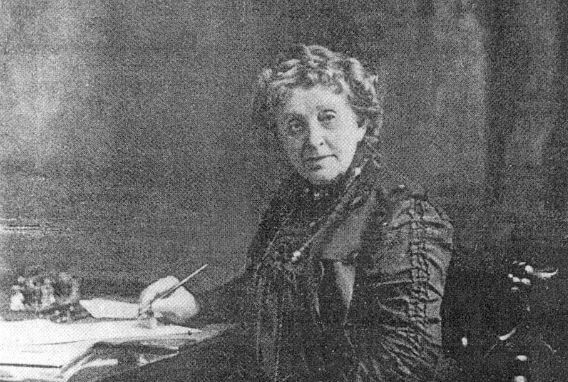
"I'll do it myself"
To protect her fine china and avoid having to hand-wash them herself, Josephine Cochrane set out to invent a better dishwashing machine.
Widowed early in this effort, she struggled against society’s limits on women, working tirelessly to build a successful prototype, sell her invention, and ultimately turn a tedious task into an iconic American appliance.
11 min read
Each month, our Journeys of Innovation series tells the stories of inventors or entrepreneurs whose groundbreaking innovations have made a positive difference in the world. Delve into the past and learn about one of history’s great innovators.
A visitor to Chicago’s South Shore between May and October 1893 would have beheld a strange and wondrous sight: Where before there was only swamp, now rose gleaming new buildings reminiscent of classic Greek temples. There were garish carnival rides as well, including the original Ferris Wheel, and canals with life-sized replicas of the Niña, the Pinta, and the Santa Maria. At the center of it all was a giant reflective pool called the Great Basin. This seemingly magic new city was the World’s Columbian Exposition of 1893, organized in part to celebrate the voyage of Christopher Columbus four hundred years earlier, but also, and more importantly, to highlight the industrial prowess and ingenuity of a confident young nation.
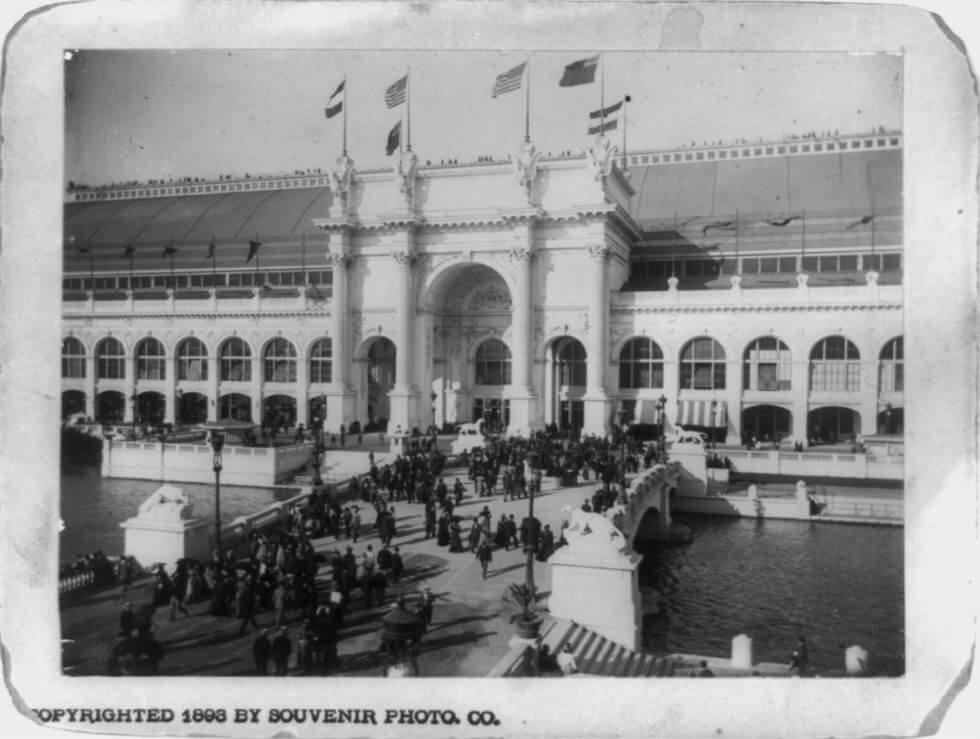
Machinery Hall, where visitors to the World’s Columbian Exposition of 1893 would have found a variety of American inventions on display, including the Garis-Cochran Dishwashing Machine.
That ingenuity was very much on display in Machinery Hall, at the edge of the Great Basin, where a variety of American inventions were on display, including the telegraph, the phonograph, and Eli Whitney’s cotton gin (patented one hundred years earlier). But it was another, more recent invention that was turning heads and drawing admirers. Into this strange-looking contraption of gears, belts, and pulleys would vanish a cage full of over 200 dirty dishes, only to reappear two minutes later as clean as if they had been hand-washed. Called the Garis-Cochran Dishwashing Machine, it was the only invention on display invented by a woman, and there were nine others just like it being used in the exposition’s many restaurants, from the Big Kitchen to the New England Clam Bake.
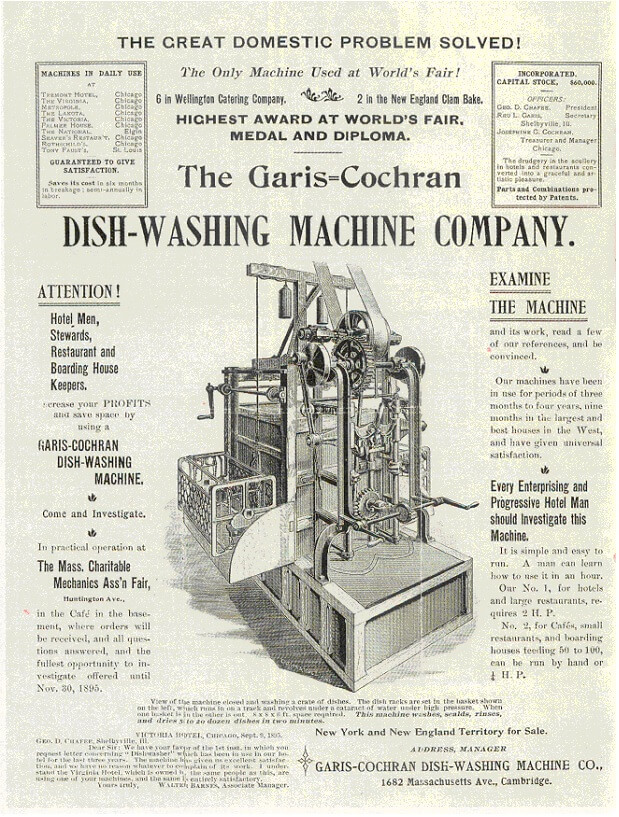
Garis-Cochran advertisements touted their invention as “the only machine used at the World’s Fair” and prominently listed the hotels who had “machines in daily use.”
The exposition’s judges were so impressed with the dishwashing machine that they awarded it the highest prize for “best mechanical construction, durability, and adaptation to its line of work.” It was just the kind of break the machine’s inventor, a widowed entrepreneur named Josephine G. Cochran, needed.
Born March 8, 1839 in Ashtabula County, Ohio, Josephine was the daughter and granddaughter of inventors and engineers. Her maternal grandfather, a Revolutionary War veteran named John Fitch, invented the first patented steamboat in the United States, and her father, John Garis, was a civil engineer who supervised a number of woolen mills, sawmills, and gristmills along the Ohio River. When faced with a problem, Josephine was by nature and upbringing determined to find a technological solution—and if one didn’t exist, to invent it.
But opportunities to innovate were rare for 19th century American women who still lacked even the right to vote, and Josephine married right out of school at the age of 19, to William A. Cochran. They had two children together: a son, Hallie, who died at age two, and a daughter, Katharine.
Having failed to strike it rich in the California Gold Rush, William eventually prospered in the dry goods business. He moved his family into a mansion in Shelbyville, Illinois, and Josephine took on the role of socialite with enthusiasm and industry. For the grand dinner parties they often hosted, she loved to use a collection of heirloom dishes purportedly dating back to the 1600s, but was distressed when she discovered the servants had chipped the dishes while washing them.
“If nobody else is going to invent a dishwashing machine, I’ll do it myself.”
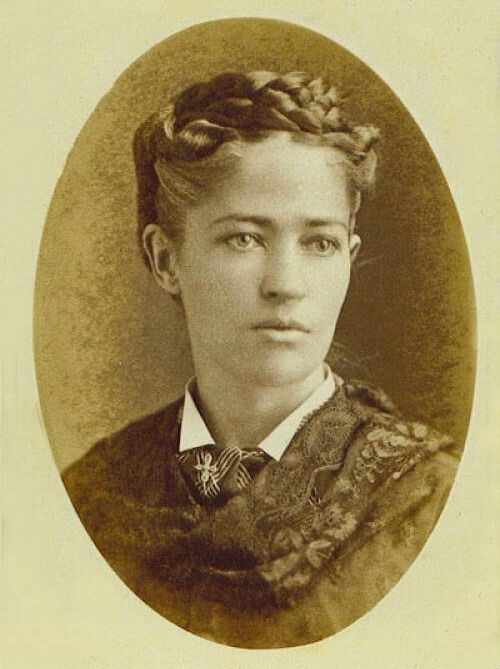
Josephine Cochran as a young woman. She married William A. Cochran at age 19 in 1858, and was widowed in 1883 shortly after conceiving the idea of a dishwasher.
Initially, Josephine resolved to wash the fine china herself, but soon became tired of this tedious task. She was convinced there had to be a mechanical solution that would make the job easier not just for herself, but others as well.
“If nobody else is going to invent a dishwashing machine, I’ll do it myself,” she vowed, quickly sketching out a design.
Around the same time, Josephine’s husband, who struggled with alcoholism, took ill and died in 1883, leaving her with just $1,500 and mounting debt. Suddenly, her invention of a viable dishwashing machine was no longer a dream but an urgent financial necessity.
Finding competent help proved difficult. “I couldn’t get men to do the things I wanted in my way until they had tried and failed in their own,” Josephine would later complain. “And that was costly for me. They knew I knew nothing, academically, about mechanics, and they insisted on having their own way with my invention until they convinced themselves my way was the better, no matter how I had arrived at it.”
Josephine filed her first patent application on New Year’s Eve, 1885, as “J.G. Cochran.” That next year, with the aid of a young mechanic named George Butters, she set to work in a woodshed behind her home bringing the first prototype to life. Although she was not the first to invent a dishwashing machine, hers was the first to use water pressure rather than scrubbers to clean the dishes, and it had racks specifically fitted to hold the dishes in place. Previous washing machines required the user to pour boiling water over the dishes.
Just after Christmas, 1886, Josephine received U.S. patent no. 355,139 for her “Dish Washing Machine.”
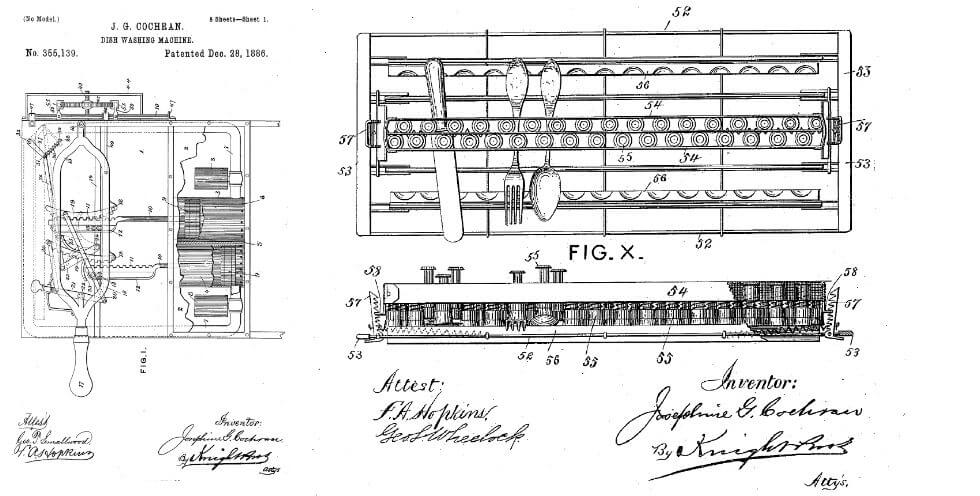
Cochran’s U.S. patent no. 355,139 for a “dish washing machine” also included a system for cleaning flatware as well as dishes (Figure X, at right).
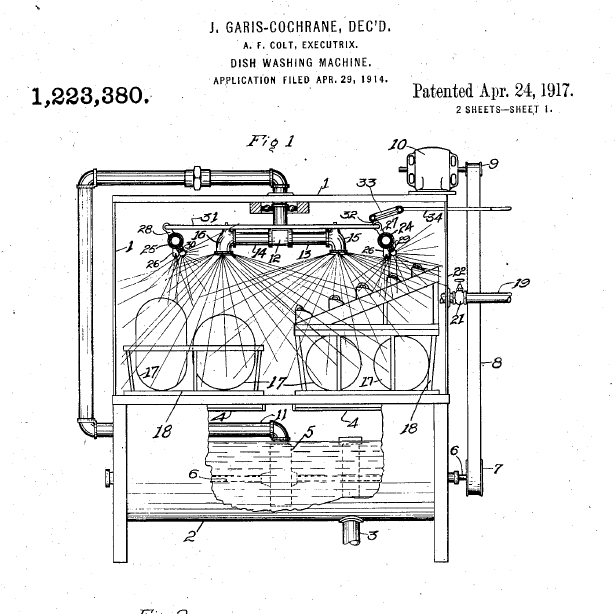
Cochran continued improving her dishwashing machine after receiving her initial patent, ultimately receiving a second, posthumous patent in 1917.
The next challenge was finding customers for her invention. During a time when domestic tasks were often divided along gender lines, she would have preferred selling the dishwashers directly to women. As she later recalled, “When it comes to buying something for the kitchen that costs $75 or $100, a woman begins at once to figure out all the other things she could do with the money. She hates dishwashing—what woman does not?—but she has not learned to think of her time and comfort as worth money. Besides, she isn’t the deciding factor when it comes to spending comparatively large sums of money for the house.”
“When it comes to buying something for the kitchen that costs $75 or $100, a woman begins at once to figure out all the other things she could do with the money. She hates dishwashing—what woman does not?—but she has not learned to think of her time and comfort as worth money.”
Instead, Josephine focused her sales pitch on larger institutions, like restaurants and hotels. In 1887, a wealthy friend introduced her to the manager of Chicago’s Palmer House, one of the most famous hotels in the country. The manager was impressed with Josephine’s pitch, and she left the meeting with her first order.
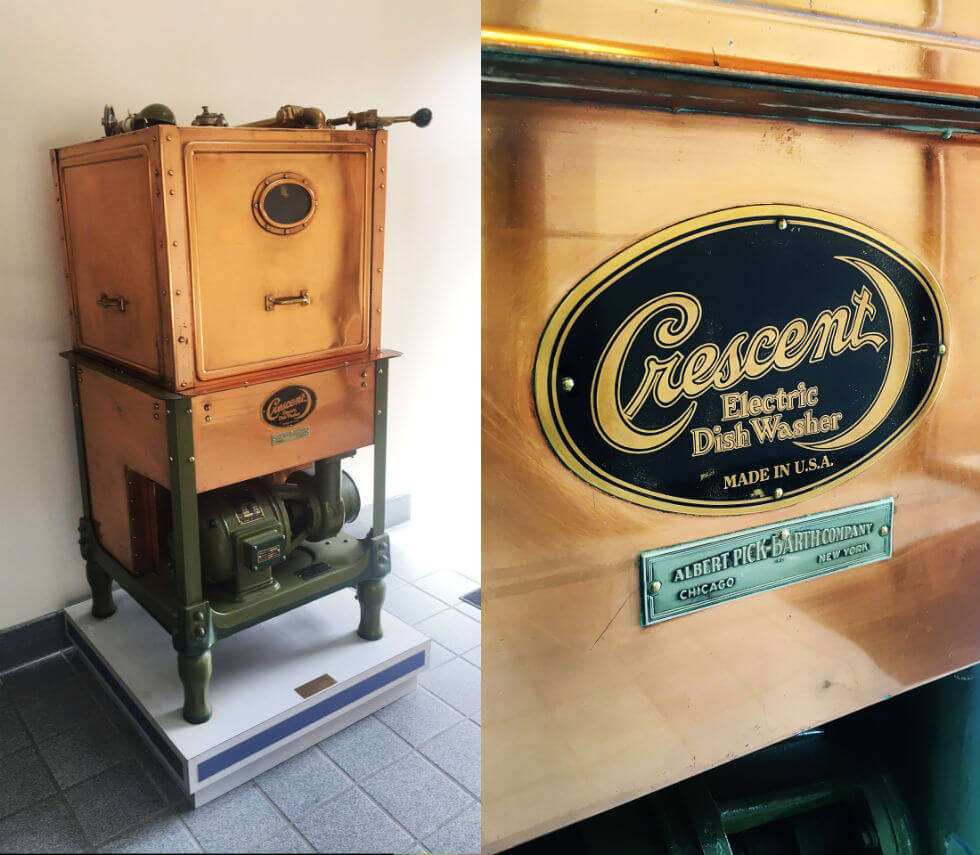
A domestic version of the electric dishwasher manufactured by Josephine Cochran’s Crescent Washing Machine Company in the early 1900s. Image courtesy of Hobart Corporation.
Next on Josephine’s list was the Sherman House hotel, but this time she would have to do it without an introduction. Though she was almost 50 years old at the time, an adult woman from her social class still did not leave home unless accompanied by a man. As Josephine later recalled, it was “almost the hardest thing I ever did, I think, crossing the great lobby of the Sherman House alone. You cannot imagine what it was like in those days…for a woman to cross a hotel lobby alone. I had never been anywhere without my husband or father—the lobby seemed a mile wide. I thought I should faint at every step, but I didn’t—and I got an $800 order as my reward.”
The Garis-Cochran Company was in business, but without enough capital to manufacture the machines on their own, it was slow going in those early years. “Mrs. Cochran is trying to get some one to form a company for the manufacture of her invention, as she is not able to establish this herself,” reported Helen M. Gougar in an 1889 issue of the Women’s Journal. “I wish that women alone might form the stockholders.”
Forty years after the birth of the women’s rights movement at Seneca Falls, New York, progress was slow. Potential investors often seemed interested only if Josephine would resign and turn the company over to the management of men. Undeterred, she pressed on without investors. It proved to be a wise decision, as many young, more heavily financed companies were wiped out in the Panic of 1893. For Josephine, however, 1893 turned out to be a major turning point in her fortunes.
The World’s Columbian Exposition that year presented a once-in-a-lifetime opportunity to gain publicity and new sales for her dishwashing machine, and it worked like a charm. Orders spiked from restaurants and hotels throughout Illinois and neighboring states, and Josephine later found willing customers in hospitals and colleges due to their strict sanitation requirements. The large-sized model of the Garis-Cochran dishwasher could wash and dry 240 dishes in two minutes, freeing staff from dishwashing duty and saving businesses vast amounts of money as a result.
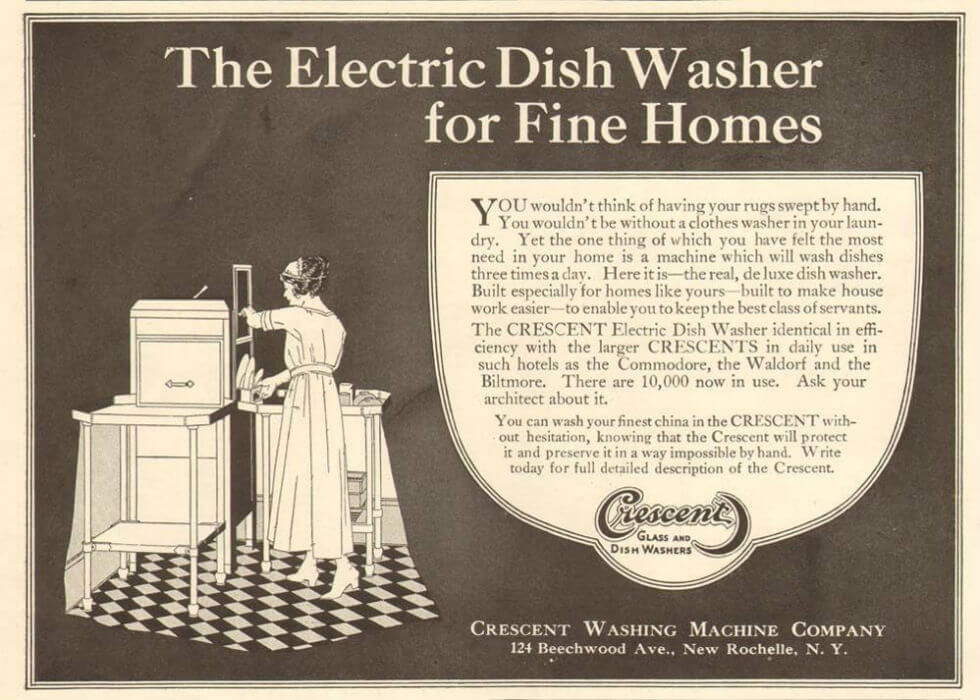
This advertisement from 1921 targeted affluent homeowners who could afford the labor-saving device. The illustration shows a maid loading a Crescent dishwashing machine, while the text promised that the device will “make housework easier—to enable you to keep the best class of servants.”
Around 1898, Josephine opened her own factory, with George Butters as manager, and began Cochran’s Crescent Washing Machine Company, expanding sales of her dishwashers to businesses as far away as Alaska and Mexico. In spite of her best efforts, domestic models still cost about $350, which was too expensive for most households, many of which also lacked a boiler large enough to handle the amounts of hot water required. Her most reliable customers continued to be hotels and restaurants.
Josephine’s journey as an inventor and entrepreneur was not an easy one, nor was she the type to ever rest on her laurels. On August 3, 1913, at age 74, she died at home in Chicago—by most accounts, from a stroke or “nervous exhaustion.” Among the lengthy obituaries and tributes to appear in the days after her death, one prominent publication noted that her “untiring efforts and remarkable ability have built up a large and profitable manufacturing business.”
“We hear only praises of her machine and among those who are personally acquainted with Mrs. Cochrane [sic] come words of the greatest admiration, respect and honor, and we feel all these are due one who has so persistently and successfully battled with the world, especially when the business pathway is not always made particularly easy for a woman to cope with.”
“If I knew all I know today when I began to put the dishwasher on the market, I never would have had the courage to start. But then, I would have missed a very wonderful experience.”
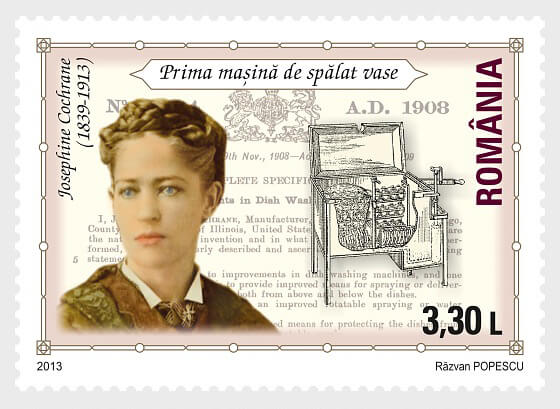
A stamp issued by Romfilatelia, the issuing authority of Romanian postage stamps, commemorated Cochran 100 years after her death. The stamp was part of a three-stamp series of innovative women.
Josephine received a second, posthumous patent in 1917 for an improved version of her dishwashing machine. In 1923, the Crescent Dishwashing Company she had founded and led received a trademark for their distinctive half-moon logo. In 1926, the company was acquired by the Hobart Manufacturing Company, which produced dishwashers under the KitchenAid brand. In 1986, KitchenAid was acquired by the Whirlpool Corporation. Although it is difficult to imagine a modern home kitchen without a dishwasher today, it wasn’t until the 1960s that Josephine’s dream was finally realized as they finally became a common household appliance.
Josephine Garis Cochran was inducted into the National Inventors Hall of Fame in 2006. As a testament to the far-reaching impact of her invention, the government of Romania—a country with which Cochran had no connection—issued a stamp with her face on it in 2013, in honor of World Intellectual Property Day.
“If I knew all I know today when I began to put the dishwasher on the market,” Josephine said near the end of her life, “I never would have had the courage to start. But then, I would have missed a very wonderful experience.”
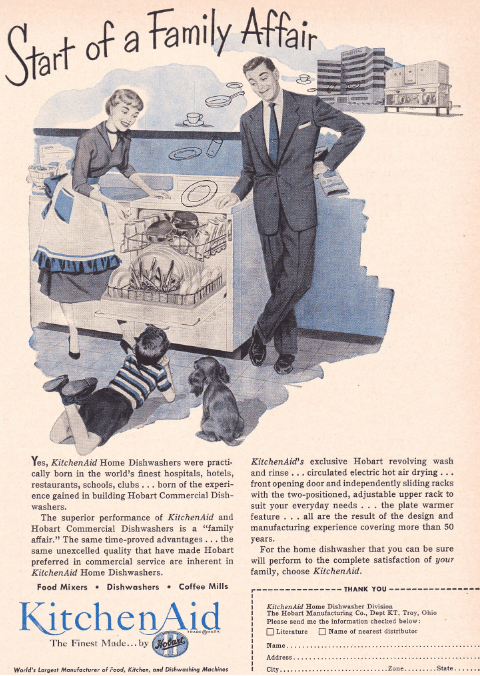
Even into the 1950s, dishwashers were not commonplace. This 1950s KitchenAid advertisement promotes the dishwasher for home use by touting its past performance in larger industrial settings like hospitals and hotels, shown in the upper right. Courtesy of KitchenAid/Whirlpool.
Credits
Produced by the USPTO Office of the Chief Communications Officer. For feedback or questions, please contact inventorstories@uspto.gov.
Story by Jocelyn Ram and Eric Atkisson. Except where noted in captions, images are public domain. Additional contributions by Jay Premack, Laura Larrimore, Steve Schatz, and Alex Camarota.
References
- David John Cole; Eve Browning; Fred E. H. Schroeder (2003). Encyclopedia of Modern Everyday Inventions. Greenwood Publishing Group. pp. 100–. ISBN 978-0-313-31345-5. https://books.google.com/books?id=rVQfBSlAZvAC&pg=PA100#v=onepage&q&f=false
- https://www.nndb.com/people/166/000165668/
- https://forgottennewsmakers.com/2010/04/20/josephine-cochrane-1839-1913-invented-the-dishwasher/
- https://www.mylifetime.com/she-did-that/december-28-1886-josephine-cochrane-secured-a-patent-for-the-dishwasher-and-saved-us-all-from-dishpan-hands
- http://www.inventionandtech.com/content/woman-who-invented-dishwasher-1?page=4
- http://www.uh.edu/engines/epi1476.htm
- Ed Sobey (2010). The Way Kitchens Work: The Science Behind the Microwave, Teflon Pan, Garbage Disposal, and More. Chicago Review Press. pp. 41–. ISBN 978-1613743072. https://books.google.com/books?id=RDfCMTQPMucC&pg=PA41#v=onepage&q&f=false
- https://www.cooksinfo.com/josephine-garis-cochrane
- https://www.independent.co.uk/life-style/gadgets-and-tech/features/the-secret-history-of-the-dishwasher-2119320.html
- https://web.archive.org/web/20150508232050/http:/woh.pdx.edu/heroine/2725
- http://xroads.virginia.edu/~MA96/WCE/tour.html



